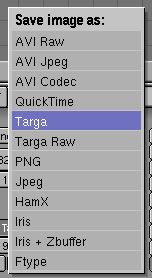Output formats
The file is saved in whichever format has been selected in the lower pop-up menu in the center-right buttons (). From here you can select many image or animation formats (Figure 14).
The default image type is Targa, but, since the image is stored in a buffer and then saved, it is possible to change the image file type after the rendering and before saving using this menu.
By default Blender renders colour (RGB) images (bottom line in ) but Black and White (BW) and colour with Alpha Channel (RGBA) are also possible.
Beware that Blender does not automatically add the extension to files, hence any .tga or .png extension must be explicitly written in the File Save window.
Except for the Jpeg format, which yields lossy compression, all the other formats are more or less equivalent. It is generally a bad idea to use JPG since it is lossy. It is better to use Targa and then convert it to JPG for web publishing purposes, keeping the original Targa.
The three AVI formats are relevant to saving animations (see also the following section):
AVI Raw - saves an AVI as uncompressed frames. Non-lossy, but huge files.
AVI Jpeg - saves an AVI as a series of Jpeg images. Lossy, smaller files but not as small as you can get with a better compression algorithm. Furthermore the AVI Jpeg format is not read by default by some players.
AVI Codec - saves an AVI compressing it with a codec. Blender automatically gets the list of your available codecs from the operating system and allows you to set its parameters. It is also possible to change it or change its settings, once selected, via the Set Codec button which appears (Figure 15).
For an AVI animation is it also possible to set the frame rate (Figure 15) which, by default, is 25 frames per second.

